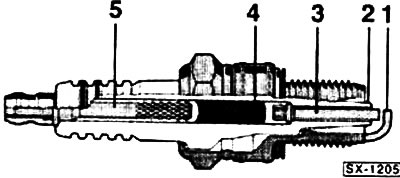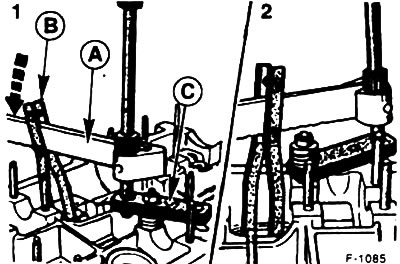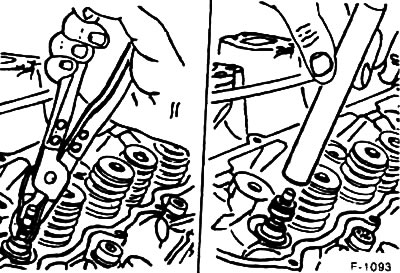Withdrawal
Apply the parking brake, shift the transmission to the neutral position.
Disconnect the spark plug ends and remove the spark plugs.
Remove the camshaft (s) and poppet pushers. see paragraphs. 1.4 and 1.12.
Gas engine
Screw the compressed air adapter HAZET 3428 together with the compressed air hose into the spark plug hole of the respective cylinder.

If there is no special tool, then an adapter for connecting compressed air can be made from an old spark plug. To do this, bite off the earth electrode -1- with wire cutters. Break off the ceramic insulator -2- with a screwdriver, break off the middle electrode, bending it to one side and the other, and remove it. Knock out the rest of the middle electrode together with the glass melt -4- and the connecting bolt -5- with a suitable punch (about 3 mm in diameter). At the same time, clamp the spark plug into a suitable removable key head.
Attention! Be careful not to damage the threads of the spark plug, this will help prevent damage to the threads in the hole in the cylinder block.
Screw the prepared spark plug into the corresponding cylinder and connect the compressed air hose.
Use this hose to continuously supply compressed air to the cylinder at an overpressure of 6 bar.
Diesel engine
Set the piston in the corresponding cylinder to TDC. After removing the spring, the valve lies on the piston. Turn the crankshaft so that the piston in the first cylinder is at TDC, see point 1.7.
If the piston in the first cylinder is at TDC, then the piston of the fourth cylinder is also at TDC. Make a chalk mark on the bottom of the V-belt pulley, then turn the crankshaft half a turn (180 deg.) so that the chalk mark is at the top. The pistons of cylinders 2 and 3 are now at TDC.
Remove the valve key from the upper valve spring seat by lightly tapping it with a hammer.

Screw on the locking plate -C- that you made yourself (see fig.) to the lock bolts of the camshaft bearing shells. Install a conventional spring compressor or Ford special tool 212-024-A- and 21-024-B-, compress the valve spring Remove the key from the valve stem.
Release the valve springs, remove the upper and lower valve spring plates, remove the valve springs.

Pull out the oil seal using pliers or special pliers. For removal, workshops use a special tool from Ford GV 2124, HAZET 791-5 or a detachable tool HAZET 791-2. All caps sit, as a rule, very firmly. For removal, therefore, if possible, use a removable tool.
Attention! Pull the caps very carefully so as not to damage their sockets.
Attention! Diesel engine: if you have removed the valve springs, the crankshaft can no longer be turned. caps for each pair of cylinders (1 and 4; 2 and 3) can only be changed as a set, and you must reinstall the spring plates and valve springs before turning the crankshaft 180°. If you turn the crankshaft with the valve springs removed, the valve will fall into the combustion chamber and you will need to remove the cylinder head.
Installation
Stick adhesive tape on the valve stem at the top to prevent damage to the oil sealing cap by the grooves when it is pushed onto the stem.
Push the new, oiled cap into the valve guide by hand.
Using a hammer and the Ford special tool, press in the oil seal. If a special tool is not available, a suitable pipe without sharp edges with the same diameter as the cap can be used.
Remove adhesive tape.
Install the valve spring with the upper spring plate and secure it.
Install the valve cotter, release the valve spring.
Replace all oil seals in the same way.
Install camshafts and poppets, see paragraphs. 1.4 and 1.12.
Diesel engine: adjust valve clearances, see paragraph 1.17.
Install the cylinder head cover.
Remove the compressed air adapter, install spark plugs, see par. 28.
Visitor comments